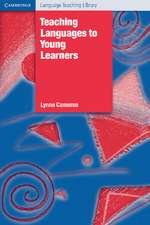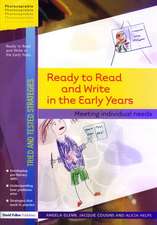Understanding the Mathematical Way of Thinking – The Registers of Semiotic Representations
Autor Raymond Duvalen Limba Engleză Hardback – 28 iul 2017
• How to situate the registers of representation regarding the other semiotic “theories” • Why use a semio-cognitive analysis of the mathematical activity to teach mathematics
• How to distinguish the different types of registers
• How to organize learning tasks and activities which take into account the registers of representation
• How to make an analysis of the students’ production in terms of registers
Building upon the contributions he first presented in his classic book Sémiosis et pensée humaine, in this volume Duval focuses less on theoretical issues and more on how his theory can be used both as a tool for analysis and a working method to help mathematics teachers apply semiotics to their everyday work. He also dedicates a complete chapter to show how his theory can be applied as a new strategy to teach geometry. “Understanding the Mathematical Way of Thinking – The Registers of Semiotic Representations is an essential work for mathematics educators and mathematics teachers who look for an introduction to Raymond Duval’s cognitive theory of semiotic registers of representation, making it possible for them to see and teach mathematics with fresh eyes.”
Professor Tânia M. M. Campos, PHD.
| Toate formatele și edițiile | Preț | Express |
|---|---|---|
| Paperback (1) | 882.96 lei 6-8 săpt. | |
| Springer International Publishing – 12 aug 2018 | 882.96 lei 6-8 săpt. | |
| Hardback (1) | 888.80 lei 6-8 săpt. | |
| Springer International Publishing – 28 iul 2017 | 888.80 lei 6-8 săpt. |
Preț: 888.80 lei
Preț vechi: 1083.90 lei
-18% Nou
Puncte Express: 1333
Preț estimativ în valută:
170.08€ • 181.87$ • 141.80£
170.08€ • 181.87$ • 141.80£
Carte tipărită la comandă
Livrare economică 18 aprilie-02 mai
Preluare comenzi: 021 569.72.76
Specificații
ISBN-13: 9783319569093
ISBN-10: 3319569090
Pagini: 119
Ilustrații: XXIV, 117 p. 50 illus., 9 illus. in color.
Dimensiuni: 155 x 235 mm
Greutate: 0.38 kg
Ediția:1st ed. 2017
Editura: Springer International Publishing
Colecția Springer
Locul publicării:Cham, Switzerland
ISBN-10: 3319569090
Pagini: 119
Ilustrații: XXIV, 117 p. 50 illus., 9 illus. in color.
Dimensiuni: 155 x 235 mm
Greutate: 0.38 kg
Ediția:1st ed. 2017
Editura: Springer International Publishing
Colecția Springer
Locul publicării:Cham, Switzerland
Cuprins
Introduction.- Chapter I Representation and knowledge: the semiotic revolution.- Chapter II Mathematical activity and the transformations of semiotic representations.- Chapter III Registers of semiotic representations and analysis of the cognitive functioning of mathematical thinking.- Chapter IV The registers: method of analysis and identification of cognitive variables.
Notă biografică
Raymond Duval is a philosopher and psychologist, devoted to researching mathematics education since the 1970s. He has worked at the Research Institute on Mathematical Education (IREM) in Strasbourg, France, from 1970 to 1995, where he developed an important research in cognitive psychology. Today, he is honorarius professor of the University du Litoral Côte d'Opale, France. His book Sémiosis et pensée humaine (1995) is a milestone in the theory of registers of semiotic representations, and his research papers over the years have greatly influenced research in mathematics education.
Textul de pe ultima copertă
In this book, Raymond Duval shows how his theory of registers of semiotic representation can be used as a tool to analyze the cognitive processes through which students develop mathematical thinking. To Duval, the analysis of mathematical knowledge is in its essence the analysis of the cognitive synergy between different kinds of semiotic representation registers, because the mathematical way of thinking and working is based on transformations of semiotic representations into others. Based on this assumption, he proposes the use of semiotics to identify and develop the specific cognitive processes required to the acquisition of mathematical knowledge. In this volume he presents a method to do so, addressing the following questions:
• How to situate the registers of representation regarding the other semiotic “theories” • Why use a semio-cognitive analysis of the mathematical activity to teach mathematics
• How to distinguish the different types of registers
• How to organize learning tasks and activities which take into account the registers of representation
• How to make an analysis of the students’ production in terms of registers
Building upon the contributions he first presented in his classic book Sémiosis et pensée humaine, in this volume Duval focuses less on theoretical issues and more on how his theory can be used both as a tool for analysis and a working method to help mathematics teachers apply semiotics to their everyday work. He also dedicates a complete chapter to show how his theory can be applied as a new strategy to teach geometry. “Understanding the Mathematical Way of Thinking – The Registers of Semiotic Representations is an essential work for mathematics educators and mathematics teachers who look for an introduction to Raymond Duval’s cognitive theory of semiotic registers of representation, making it possible for them to see and teach mathematics with fresh eyes.”
Professor Tânia M. M. Campos, PHD.
• How to situate the registers of representation regarding the other semiotic “theories” • Why use a semio-cognitive analysis of the mathematical activity to teach mathematics
• How to distinguish the different types of registers
• How to organize learning tasks and activities which take into account the registers of representation
• How to make an analysis of the students’ production in terms of registers
Building upon the contributions he first presented in his classic book Sémiosis et pensée humaine, in this volume Duval focuses less on theoretical issues and more on how his theory can be used both as a tool for analysis and a working method to help mathematics teachers apply semiotics to their everyday work. He also dedicates a complete chapter to show how his theory can be applied as a new strategy to teach geometry. “Understanding the Mathematical Way of Thinking – The Registers of Semiotic Representations is an essential work for mathematics educators and mathematics teachers who look for an introduction to Raymond Duval’s cognitive theory of semiotic registers of representation, making it possible for them to see and teach mathematics with fresh eyes.”
Professor Tânia M. M. Campos, PHD.
Caracteristici
Presents a new way to teach and learn mathematics Provides a method for teachers to use the registers of semiotic representations theory in their everyday work at the classroom Explains how to develop the cognitive processes required to the acquisition of mathematical knowledge Includes supplementary material: sn.pub/extras









